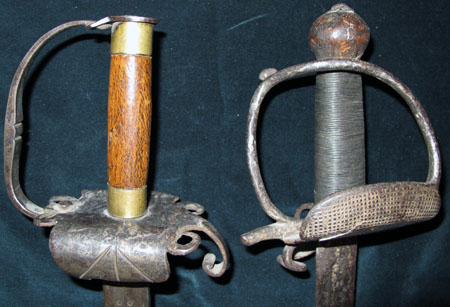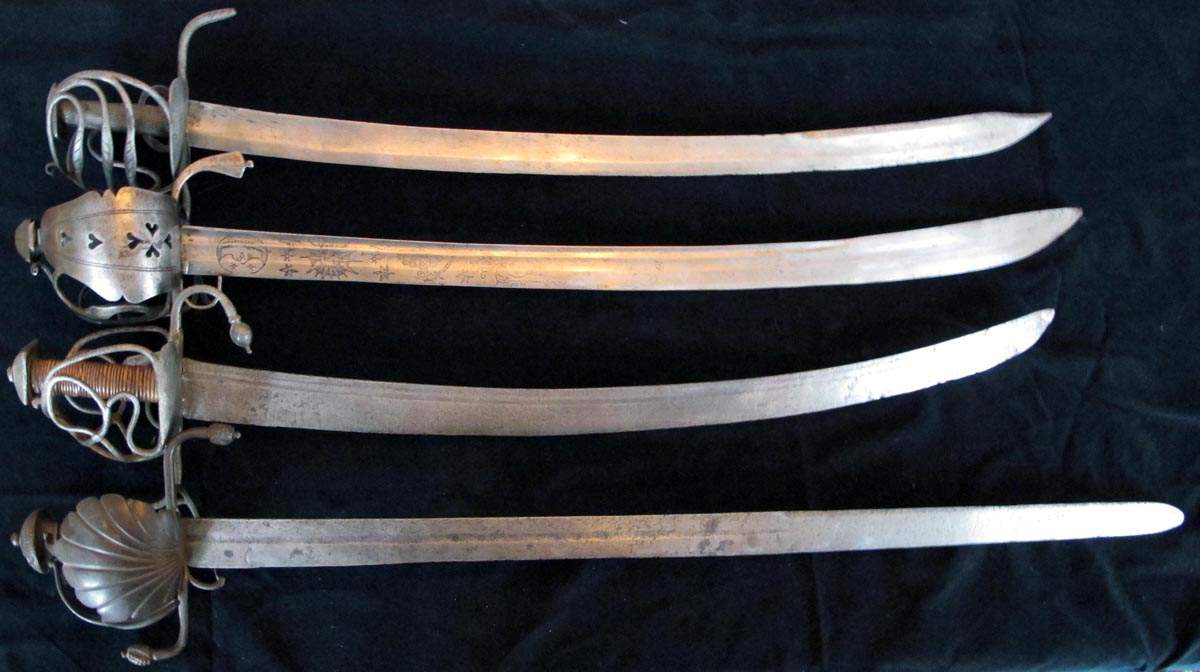Tessak – The Farmer’s Sword
In preparation for the new Norwegian law to  be enforced in 1604, Christian IV started buying swords to be sold to the farmers already in 1589. The law would state that all farmers were to be armed according to the size of their farm and the Tessak Sword would become the most common weapon amongst the farmers. The swords were purchased
be enforced in 1604, Christian IV started buying swords to be sold to the farmers already in 1589. The law would state that all farmers were to be armed according to the size of their farm and the Tessak Sword would become the most common weapon amongst the farmers. The swords were purchased  several times between 1589 and 1617, some probably second hand and some new, and sold at cost price to the farmers. There was probably purchased a total of at least 8000 swords, out of which some 4-500 still exist. The origin of these swords are uncertain, but
several times between 1589 and 1617, some probably second hand and some new, and sold at cost price to the farmers. There was probably purchased a total of at least 8000 swords, out of which some 4-500 still exist. The origin of these swords are uncertain, but  they probable come from the south-eastern Germany or Bohemia. Similar swords are strangely enough also found in Switzerland, but as far as I know, nowhere else in quantity.
they probable come from the south-eastern Germany or Bohemia. Similar swords are strangely enough also found in Switzerland, but as far as I know, nowhere else in quantity.
These swords were traditionally called Sinclair sabers in Norway, as they earlier  were thought to have belonged to the Scottish mercenaries that more or less were butchered at The Battle of Kringen, Gudbrandsdalen in 1612. They were mistaken for being very early Scottish broadswords.
were thought to have belonged to the Scottish mercenaries that more or less were butchered at The Battle of Kringen, Gudbrandsdalen in 1612. They were mistaken for being very early Scottish broadswords.
The Tessak usually most often had a curved blade with a shallow, wide fuller all the way  down the blade. They are also to be found with other curved blades, with straight single- or twin-edged blades and, of course, with a variety of secondary blades. I even have a tessak fitted with the super-scarce F4 M1705 blade.
down the blade. They are also to be found with other curved blades, with straight single- or twin-edged blades and, of course, with a variety of secondary blades. I even have a tessak fitted with the super-scarce F4 M1705 blade.
The hilts are very varied and have been sorted into eight categories. The drawing to the left shows the different types (from Hærmuseets Årbok 1971-72), but there are significant variations within each category and I also have a couple of hilts that don’t really match any of them.
The tessak arrived in Norway around the year 1600. Every year the farmer had to bring his weapons to the Våpenting (weapons meet) in order to prove that he still had his mandatory weapons and that they were in good order. If not, he was fined. I am not sure when the Våpenting was abolished, probably in the late 1700’s when the swords already were 150 years old – or so. This is probably the  reason why there still is a
reason why there still is a  fair percentage of these swords in existence in surprisingly good order.
fair percentage of these swords in existence in surprisingly good order.
In addition to the relics and swords that have buried in the ground, one also finds swords made out of parts that most probably came from tessak’s. The two hilts on the left are possible examples of this.
The Norwegian farmers had a tough time in the 1700’s. There was “The Little Ice-age” where the crops failed and famine was wide  spread and the heavy Danish taxation. A lot of the tessak’s were probably made into farm tools or sold for scrap value.
spread and the heavy Danish taxation. A lot of the tessak’s were probably made into farm tools or sold for scrap value.
Most pictures on this site and all the pictures on this page are “click-able”. You then get a larger picture with more details.

